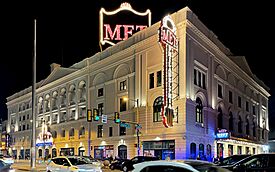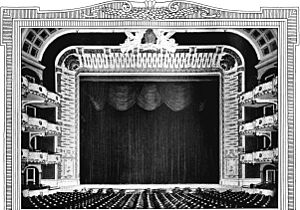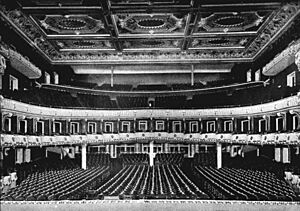Metropolitan Opera House (Philadelphia) facts for kids

Exterior view of the theatre (2024)
|
|
| Former names | Philadelphia Opera House (1908-10) Metropolitan Opera House (1910-84) Philadelphia Evangelistic Center (1984-88) |
|---|---|
| Address | 858 N Broad St Philadelphia, PA 19130-2234 |
| Location | Fairmount |
| Coordinates | 39°58′13″N 75°9′38″W / 39.97028°N 75.16056°W |
| Owner | Eric Blumenfeld |
| Operator | Live Nation Philadelphia |
| Capacity | 3,500 |
| Construction | |
| Opened | November 17, 1908 |
| Renovated |
|
| Closed | 1988 |
| Reopened | December 3, 2018 |
| Construction cost | $2 million ($65.1 million in 2022 dollars ) |
| Architect | William H. McElfatrick |
| Structural engineer | Phoenix Iron Company |
| General contractor |
|
|
Building details
|
|
| General information | |
| Renovation cost | $56 million |
| Renovating team | |
| Architect | Atkin Olshin Schade Architects |
| Structural engineer | David Chou & Associates |
| Services engineer | Concord Engineering Group |
| Main contractor | Domus Construction |
|
Metropolitan Opera House
|
|
| Architectural style | Classical Revival |
| NRHP reference No. | 72001163 |
| Significant dates | |
| Added to NRHP | February 1, 1972 |
The Metropolitan Opera House is a very old and famous building in Philadelphia, Pennsylvania. It started as an opera house and is now a popular place for pop concerts. Today, it's known as The Met.
This theatre has been used for many different things over the years. After a big makeover, it opened again in December 2018 as a concert hall. A company called Live Nation Philadelphia helps manage it.
The Met was built very quickly in 1908. It was the ninth opera house created by Oscar Hammerstein I, a person who loved putting on shows. At first, it was home to Hammerstein's own Philadelphia Opera Company and was called the "Philadelphia Opera House".
In 1910, Hammerstein sold the building to the Metropolitan Opera from New York City. That's when its name changed to the Metropolitan Opera House. The Met used the theatre until 1920. After that, many other opera groups performed there until 1934.
For over 50 years, the building was used in many ways. It was a movie theater, a ballroom, a place for sports, and even a church. The building then became very run-down and was empty from 1988 to 1995. In 1995, it became the "Holy Ghost Headquarters Revival Center at the Met". The church helped fix up a lot of the building. This work eventually led to the latest big renovation of the opera house in 2017–2018.
The opera house has been listed on the National Register of Historic Places since 1972. This means it's a special building that is important to history.
Contents
History of The Met Philadelphia
The Metropolitan Opera House was built by Oscar Hammerstein I. He wanted it to be the main home for his new group, the Philadelphia Opera Company (POC). Hammerstein hired an architect named William H. McElfatrick in 1907 to design the opera house. Building started the next year.
When it opened in 1908 as the Philadelphia Opera House, it was the biggest theatre of its kind in the world. It could hold more than 4,000 people!
Opening Night and Early Opera Years
The opera house officially opened on November 17, 1908. The first show was an opera called Carmen by Georges Bizet. This was the start of the Philadelphia Opera Company's first season. The company continued to use the house for its shows until March 1910. Their last performance there was Rigoletto by Giuseppe Verdi on March 23, 1910.
On April 26, 1910, Oscar Hammerstein's son, Arthur, sold the Philadelphia Opera House. He sold it to the New York Metropolitan Opera. The theatre was then renamed the Metropolitan Opera House. The New York Met used to visit Philadelphia every year. They were the biggest rivals to Hammerstein's opera company. Even though Hammerstein's company had two very popular seasons, he ended up in debt. He had to sell his famous opera house to his competitor.
The New York Met's first show at the renamed theatre was on December 13, 1910. The Met performed regularly at the MOH for the next ten years. They put on over a hundred shows there. The Metropolitan Opera's last performance at the MOH was Eugene Onegin on April 20, 1920.
Even when the New York Met owned the MOH, they also rented it out to other opera groups. The theatre was home to the Philadelphia-Chicago Grand Opera Company from 1911 to 1914. Other groups like the Philadelphia Operatic Society also used the house. After the New York Met moved back to performing at the Academy of Music in 1920, the MOH became home to the Philadelphia Civic Opera Company until 1928. Many other opera companies from different cities also performed there. The last opera show at the MOH was on May 5, 1934. It was two operas, Cavalleria rusticana and Pagliacci, performed by the Chicago Grand Opera Company.
Changes Over the Years
By 1920, the house started showing silent films, which were movies without sound. It kept being a movie theatre even after opera shows stopped. In 1922, the first radio broadcast from the Metropolitan Opera House happened.
In the late 1930s, the MOH became a ballroom where people could dance. In the 1940s, a sports promoter bought the place. They covered the orchestra pit with a floor so that basketball, wrestling, and boxing matches could happen there. This sports venture closed when fewer people came. This was partly because the area around the theatre became less popular. In 1954, the building was sold and became a church.
Challenges and Comeback
In 1954, Reverend Theo Jones bought the building for his large church group. During this time, the Philadelphia Orchestra even used the Met to record music. They liked the great sound quality inside the building. However, after 1988, fewer people attended the church. The building started to fall apart. City officials even said the building was dangerous.
But in 1996, Reverend Mark Hatcher bought it for his Holy Ghost Headquarters Revival Center. This saved the building from being torn down. Between 1997 and 2013, the church spent about $5 million to make the building stable again.
In 2012, the Holy Ghost Headquarters Church and a developer named Eric Blumenfeld decided to work together. Blumenfeld eventually bought the building for just $1. Some work to remove parts inside the building started in 2013. But it stopped because the developer didn't have the right permits. In 2015, the church sued the developer. They said Blumenfeld didn't keep his promises. They claimed he "gutted the auditorium the church had worked so hard to renovate" and left the project unfinished.
The Met's Big Renovation
In May 2017, Blumenfeld and the Holy Ghost Church reached a new agreement to own the building together. At the same time, Live Nation, a company that puts on concerts, signed a deal to use the building. They announced a $45 million renovation project. The goal was to bring the theatre back as a concert venue that could also be used for other things. It would also continue to be the home of the Holy Ghost Church.
Atkin Olshin Schade Architects led the restoration work, and Domus Construction was the main builder. The completely renovated Met Philadelphia reopened to the public on December 3, 2018. The first concert was by the famous musician Bob Dylan. One year later, on December 3, 2019, Sirius XM radio hosted a special, smaller concert by the band Phish at The Met.
See also
 In Spanish: Metropolitan Opera House (Filadelfia) para niños
In Spanish: Metropolitan Opera House (Filadelfia) para niños



